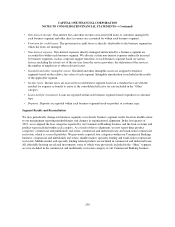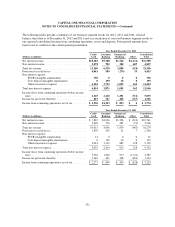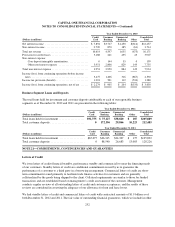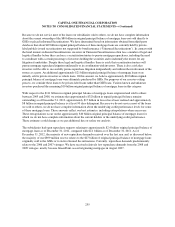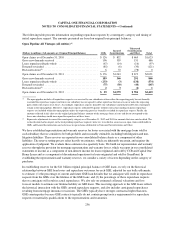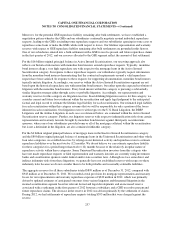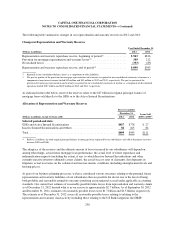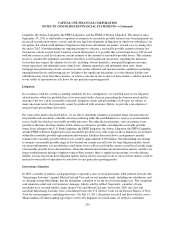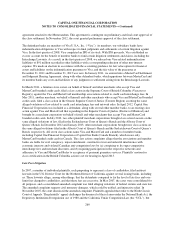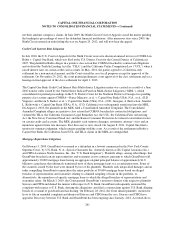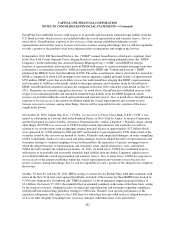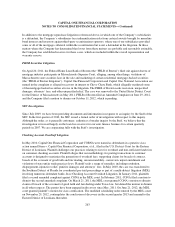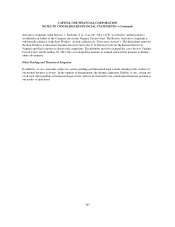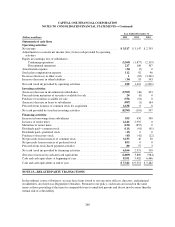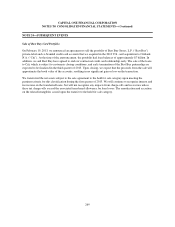Capital One 2012 Annual Report Download - page 278
Download and view the complete annual report
Please find page 278 of the 2012 Capital One annual report below. You can navigate through the pages in the report by either clicking on the pages listed below, or by using the keyword search tool below to find specific information within the annual report.CAPITAL ONE FINANCIAL CORPORATION
NOTES TO CONSOLIDATED FINANCIAL STATEMENTS—(Continued)
Litigation, the Ambac Litigation, the FHFA Litigation, and the FHLB of Boston Litigation. The increase since
September 30, 2012 is attributable to updated assessments of reasonably possible future losses based primarily on
increased securitization trustee activity and adverse legal developments in litigation in which our subsidiaries are
not parties, but which could influence litigation in which our subsidiaries are parties, in each case occurring after
the end of 2012. Notwithstanding our ongoing attempts to estimate a reasonably possible amount of future loss
beyond our current accrual levels based on current information, it is possible that actual future losses will exceed
both the current accrual level and our current estimate of the amount of reasonably possible losses. This estimate
involves considerable judgment, and reflects that there is still significant uncertainty regarding the numerous
factors that may impact the ultimate loss levels, including, but not limited to, anticipated litigation outcomes,
future repurchase and indemnification claim levels, ultimate repurchase and indemnification rates, future
mortgage loan performance levels, actual recoveries on the collateral and macroeconomic conditions (including
unemployment levels and housing prices). In light of the significant uncertainty as to the ultimate liability our
subsidiaries may incur from these matters, an adverse outcome in one or more of these matters could be material
to our results of operations or cash flows for any particular reporting period.
Litigation
In accordance with the current accounting standards for loss contingencies, we establish reserves for litigation
related matters when it is probable that a loss associated with a claim or proceeding has been incurred and the
amount of the loss can be reasonably estimated. Litigation claims and proceedings of all types are subject to
many uncertain factors that generally cannot be predicted with assurance. Below we provide a description of
material legal proceedings and claims.
For some of the matters disclosed below, we are able to determine estimates of potential future outcomes that are
not probable and reasonably estimable outcomes justifying either the establishment of a reserve or an incremental
reserve build, but which are reasonably possible outcomes. For other disclosed matters, such an estimate is not
possible at this time. For those matters below where an estimate is possible, excluding the reasonably possible
future losses relating to the U.S. Bank Litigation, the DBSP Litigation, the Ambac Litigation, the FHFA Litigation,
and the FHLB of Boston Litigation because reasonably possible losses with respect to those litigations are included
within the reasonably possible representation and warranty liabilities discussed above, management currently
estimates the reasonably possible future losses could be approximately $150 million. Notwithstanding our attempt
to estimate a reasonably possible range of loss beyond our current accrual levels for some litigation matters based
on current information, it is possible that actual future losses will exceed both the current accrual level and the range
of reasonably possible losses disclosed here. Given the inherent uncertainties involved in these matters, and the very
large or indeterminate damages sought in some of these matters, there is significant uncertainty as to the ultimate
liability we may incur from these litigation matters and an adverse outcome in one or more of these matters could be
material to our results of operations or cash flows for any particular reporting period.
Interchange Litigation
In 2005, a number of entities, each purporting to represent a class of retail merchants, filed antitrust lawsuits (the
“Interchange Lawsuits”) against MasterCard and Visa and several member banks, including our subsidiaries and
us, alleging among other things, that the defendants conspired to fix the level of interchange fees. The complaints
seek injunctive relief and civil monetary damages, which could be trebled. Separately, a number of large
merchants have asserted similar claims against Visa and MasterCard only. In October 2005, the class and
merchant Interchange Lawsuits were consolidated before the U.S. District Court for the Eastern District of New
York for certain purposes, including discovery. On July 13, 2012, the parties executed and filed with the court a
Memorandum of Understanding agreeing to resolve the litigation on certain terms set forth in a settlement
259



